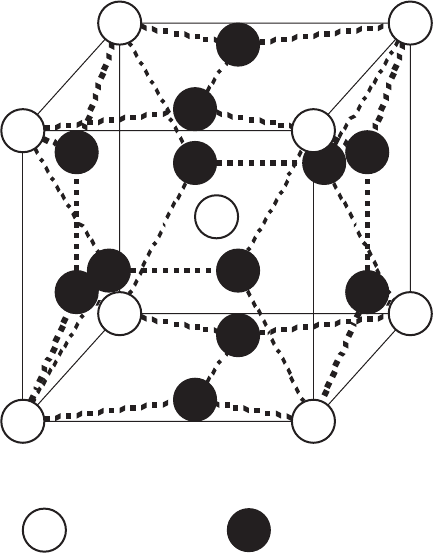Parinov I.A. Microstructure and Properties of High-Temperature Superconductors
Подождите немного. Документ загружается.


10.5 Current Percolation and Pinning of Magnetic Flux in HTSC 483
0.00
0.81
(0.71)
0.15
(a) (b)
(c)
0.59
(0.23)
0.40
0.65
(0.19)
0.38
(0.28)
0.54
(0.44)
0.52
0.38
(0.09)
0.60
(0.50)
0.85
(0.75)
Fig. 10.32. An example of percolating cluster growing in BSCCO bulk. Numbers de-
note probabilities of cell occupation (in brackets there are considered probabilities).
A cross corresponds to the cluster cell at previous step. Microcracks are presented
at GBs
grains. The modification of the ant into maze algorithm for this example is
the following. When the considered cell is separated from the main one by an
intercrystalline boundary and the grains have the same orientation, then its
probable number is decreased by 0.1 (for designation of the predominant clus-
ter growth within the grain). If these grains have different orientations, then
an additional generated probable number is multiplied by the corresponding
value of the considered cell, so taking into account the grain connectivity. An
example of the cluster growth is shown in Fig. 10.32 and the obtained results
are presented in Table 10.4 [577].
The percolation properties have been calculated for t = 100. The com-
puted relative increasing of the mean quadratic displacement, R/R
0
,andthe
joining cluster area, S/S
0
(where R
0
and S
0
are corresponding values for the
case D/δ =2.40), together with a decreasing of total GBs length (l
i
/l
0
i
)inthe
case of the larger grain growth coincide with test data (e.g., for large-grain
Table 10.4. Numerical results
D/δ l
i
/l
0
i
R/R
0
S/S
0
2.40 1.00 1.00 1.00
2.84 0.86 1.85 1.52
484 10 Modeling of Electromagnetic and Superconducting Properties of HTSC
melt-processed HTSCs, considered in detail in Sect. 3.4). A comparison of
the obtained results with estimations of the strength properties, presented
in Sect. 8.6, shows that the denser lattice of the intergranular boundaries
and, especially, the misorientation of adjacent grains affect the degradation of
transport properties in a greater degree in the case of fine-grain ceramic com-
pared to some increased microcracking of larger-grain structures. Thus, the
greater toughening of the Bi-2223 bulks by ductile Ag particles (a fine-grain
case) and the increased conductivity (a large-grain case) demand optimization
of both contributions in the estimation of the HTSC properties.

A
Classification of Superconductors
Some main properties (including superconducting ones) of different chemical
elements are shown in color inset. Here, a classification of known supercon-
ducting compounds is carried out. One includes 13 types of compounds,
namely organic superconductors, A-15 compounds, magnetic superconduc-
tors, heavy fermions, oxides without copper, pyrochlore oxides, rutheno-
cuprates, high-temperature superconductors, rare-earth borocarbides, silicon
superconductors, chalcogens, carbon superconductors, MgB
2
and related com-
pounds. The last section is devoted to room-temperature superconductivity.
A.1 Organic Superconductors
The organo-metallic compounds, discovered in 1979, have double bonds and
can provide electrons to form Cooper pairs. There are vibration modes so
that a phonon-induced mechanism is feasible. Moreover, the electrons may
become attractive due to strong correlations, in which a phonon mech-
anism is not required. Majority of organic superconductors demonstrate
co-existence of superconductivity and antiferromagnetism [300]. The crit-
ical temperatures, T
c
, for BT=BEDT-TTF (BEDT = bis(ethylenedithio),
TTF = tetrathiafulvalene) compounds [993] are given in Table A.1. The prop-
erties of these superconductors depend on pressure and on annealing proce-
dure. The critical temperatures of most of these compounds are < 10 K.
The mechanical loading leads to change of Fermi surface. The stress par-
allel to conducting planes of quasi-two-dimensional organic superconductor
k-(BEDT-TTF)
2
Cu(SCN)
2
, causes an increase of T
c
and H
c2
, but the perpen-
dicular stress leads to their decrease. As it is known, superconductivity can
be destroyed by a sufficiently high magnetic field. However, this is not always
true. The organic superconductor k-(BEDT-TTF)
2
Cu(SCN)
2
demonstrates
Fulde-Ferrell-Larkin–Ovchinnikov (FFLO) effect, namely superconductivity
could be observed only in strong magnetic field. FFLO superconductivity ini-
tiates when an electron with spin “up” interacts with a hole with spin “down.”

486 A Classification of Superconductors
Table A.1. The properties of several organo-metallic compounds with
BT = BEDT − TTF [BEDT = bis(ethylenedithio), TTF = tetrathiafulvalene]
No. Formula Phase Pressure (kbar) T
c
(K)Remarks
1(BT)
2
ReO
4
–4 2.0
2(BT)
2
I
3
α 03.3I
2
doped
3(BT)
2
I
3
β
L
01.5
4(BT)
2
I
3
β
L
0 2.0 Annealed
5(BT)
2
I
3
β
H
0.5 8.1
6(BT)
2
I
3
α
t
08.1
7(BT)
2
IBr
2
β 0 2.2–3.0
8(BT)
2
AuI
2
β 0 3.4–5.0
9(BT)
2
I
3−2.5
γ 02.5
10 (BT)
2
I
3
θ 03.6
11 (BT)
2
I
3
k 03.6
12 (BT)
4
Hg
2.89
Br
8
–0 4.0
13 (BT)
4
Hg
2.89
Cl
8
–12 1.8
14 (BT)
3
Cl
2
(H
2
O)
2
–16 2.0
15 (BT)
2
Cu(NCS)
2
k 0 10.4
16 (BT)
2
Cu[N(CN)
2
]Br k 0 11.5
In this case, “Cooper pair” of a new type forms, the necessary condition being
an external magnetic field directed strictly along BEDT-TTF layers [994].
In other quasi-two-dimensional organic conductor λ-(BETS)
2
FeCl
4
,where
BETS = bis(ethylenedithio)tetraselenafulvalene, the superconducting phase
is induced by a magnetic field exceeding 18 T [1093]. Crystalline λ-(BETS)
2
FeCl
4
consists of layers of highly conducting BETS sandwiched between in-
sulating layers of iron chloride. The field is applied parallel to the conducting
layers. At the same time this compound, at zero field, is an antiferromagnetic
insulator below 8.5 K. By increasing the applied magnetic field value above
41 T, this compound becomes metallic at 0.8 K. The dependence T
c
(B)hasa
bell-like shape with a maximum T
c
≈ 4.2 K near 33 T. It is interesting to note
that a magnetic field of only 0.1 T applied perpendicular to conducting BETS
planes destroys the superconducting state. Thus, in this organic conductor,
there is a strong superconductivity along the c-axis and weak in the ab-plane
(in cuprates, it is the other way round).
A.2 A-15 Compounds
Chemical compounds of binary composition A
3−x
B
1+x
crystallize into many
different structures, depending on the value of x, temperature and pressure.
One of the structures existing near x =0,A
3
B (where A =Nb,V,Ta,Zr
and B = Sn, Ge, Al, Ga, Si) has the structure of beta-tungsten, designated in
crystallography by the symbol A-15, and is superconducting. Hardy and Hulm

A.2 A-15 Compounds 487
first discovered A-15 superconductor (V
3
Si) in 1954. Intermetallic compound
Nb
3
Ge has a critical temperature T
c
=23.2 K, while Nb
3
Ga shows T
c
=
20.7K, Nb
3
Al,T
c
=19.1K and Nb
3
Sn,T
c
=18.3 K. Figure A.1 shows the
structure of the binary A
3
B compound. The transition temperatures of several
A − 15 structures are given in Table A.2.
The critical temperature and second critical field increase in Nb
3
Al com-
pound, adding Ge and Cu in Nb/Al at the initial stage of the rapid heat-
ing, quenching and transforming (RQHT) process [463], and they attain for
Nb
3
Al-Ge(T
c
=19.4K,H
c2
=39.5T) and for Nb
3
Al-Cu(T
c
=18.2K,H
c2
=
28.7 T) [462]. Moreover, the superconductors Nb
3
Al-Ge, Cu have highest crit-
ical current densities among all metallic multifilamentary superconductors at
H>20 T and T =4.2 K. Only significantly more expensive HTSC, based on
Bi-2223 and Bi-2212, have the near values of supercurrent at T<20 K.
AB
Fig. A.1. Crystalline structure of A
3
B compound (A − 15 superconductors). The
atoms A form one-dimensional chains on each face of the cube. Chains on the
opposite faces are parallel, while on the neighboring faces they are orthogonal to
each other

488 A Classification of Superconductors
Table A.2. The critical temperatures, T
c
(K), of A-15 compounds
Ti
3
Sb 6.5 Ti
3
Ir 4.2
Zr
80
Sn
20
q
0.92 Ti
3
Pt 0.5
Zr-Pb 0.76 V
29
Re
71
8.4
Zr
∼3
Bi
p
3.4 V
50
Os
50
5.7
V-Al
f
11.8 V
65
Rh
35
≈ 1
V
3
Ga 15.9 V
63
Ir
37
1.7
V
3
Si 17.0 V
∼3
Pd 0.08
V
∼3
Ge 6.0–7.5 V
3
Pt 3.7
V
∼3
Ge
f
6.0–11.0 Nb
75
Os
25
1.0
V
∼79
Sn
∼21
4.3 Nb
75
Rh
25
2.6
V-Sn
q
7.0–17.0 Nb
72
Ir
28
3.2
V
77
As
23
0.2 Nb
3
Pt 11.0
V
76
Sb
24
0.8 Ta
85
Pt
15
0.4
Nb
3
Al 19.1 Cr
72
Ru
28
3.4
Nb
3
Be 10.0 Cr
73
Os
27
4.7
Nb
3
Ga 20.7 Cr
78
Rh
22
0.07
Nb
3
Pb 5.6 Cr
82
Ir
18
0.75
Nb
∼3
In
p
8.0–9.2 Mo
40
Tc
60
13.4
Nb
82
Si
8
q
4.4 Mo
∼65
Re
∼35
f
≈ 15 (A-15)
Nb-Si
f
9.3 Mo
75
Os
25
12.7
Nb-Si
f
4.0–8.0 Mo
78
Ir
22
8.5
Nb-Si
f
11.0–17.0 Mo
82
Pt
18
4.6
Nb-Ge
q
6.0–17.0 W
∼60
Re
∼40
f
11.0
Nb-Ge
f
23.2 Ta
∼80
Au
20
0.55
Nb
3
Sn 18.3 Zr
3
Au 0.9
Nb-Sb 2.0 V
76
Au
24
3.0
Nb
∼3
Bi
p
3.0 Nb
∼3
Au 11.5
Ta
∼3
Ge
f
8.0
Ta
∼3
Sn 8.3
Ta
∼3
Sb 0.7
Mo
3
Al 0.58
Mo
3
Ga 0.76
Mo
77
Si
23
1.7
Mo
77
Ge
23
1.8
The left column has no transition metals; the right column has transition metals;
three alloys of gold are also included. Note: q = quenching, p = pressure, f=film
A.3 Magnetic Superconductors (Chevrel Phases)
In 1971, Chevrel and co-workers discovered a new class of ternary molybdenum
sulfides having the general chemical formula M
x
Mo
6
S
8
,whereM stands for
a large number of metals and rare earths. These superconductors have un-
usually high values of the upper critical field, B
c2
, given in Table A.3 [737].
The superconducting compounds REMo
6
X
8
(where RE =Gd,Tb,Dy,Er
and X =S,Se,Te),andRERh
4
B
4
(where RE = Nd, Sm, Tm) are usually

A.3 Magnetic Superconductors (Chevrel Phases) 489
Table A.3. The critical temperature and the upper critical magnetic field of Chevrel
phases
No. Compound T
c
(K) B
c2
(T)
1PbMo
6
S
8
15 60
2LaMo
6
S
8
7 44.5
3 SnMo
6
S
8
12 36
related to the Chevrel phases [1028]. Magnetic superconductors demonstrate
some novel features not found in conventional type-I superconductors. Upon
cooling from the superconducting phase (T<T
c
), the material becomes
normal again at a low temperature and the superconductivity is destroyed.
Very often this normal phase is magnetically ordered. Upon cooling from the
normal state the system becomes superconducting below T
c
, and upon further
cooling it becomes magnetically ordered below Neel temperature, T
N
(where
T
N
<T
c
). Thus, the superconducting phase occurs only in a limited range
of temperatures, T
N
<T <T
c
. The interaction of conduction electrons with
magnetic atoms leads to the formation of a bound state of the electron with the
magnetic atom below a certain characteristic temperature called the Kondo
temperature. It was found that the resistivity of a magnetic alloy, such as Fe
impurities in Cu shows a minimum in the resistivity as a function of tempera-
ture due to the interaction of conduction electrons of the metal atom with the
magnetic moment of the magnetic atom. Such a Kondo effect exists in super-
conductors containing magnetic impurity atoms at low temperatures, because
the superconductivity is destroyed. In the case of magnetic superconductors,
there is a sub-lattice of magnetic atoms in addition to the lattice of metallic
atoms, so that magnetically ordered phase exists at low temperatures below
the superconducting phase, T
N
<T
c
.
While ferromagnetic superconductors (e.g., ErRh
4
B
4
and HoMo
6
S
8
)
demonstrate the above behavior, the antiferromagnetic superconductors (e.g.,
REMo
6
S
8
,whereRE = Gd, Tb, Dy and Er and also RERh
4
B
4
,where
RE = Nd, Sm and Tm) present examples of the co-existence of the two phases
together with anomalous behavior of the second critical field. In ErRh
4
B
4
,pos-
sessing tetragonal structure with a =5.299
˚
Aandc =7.588
˚
A, a plot of the
ac-magnetic susceptibility (χ
ac
) and electric resistancedepictsanormalto
superconducting transition at T
c1
=8.7 K, followed by a loss of susceptibility
at T
c2
=0.9 K together with the appearance of the ferromagnetic long-range
order. This result takes place at zero magnetic field. At non-zero finite field
also, the resistance disappears at some temperature interval within the above
domain. The compound HoMo
6
S
8
becomes superconducting at T
c1
=1.3K
in zero field. On further cooling, it becomes normal at T
c2
=0.6 K together
with the appearance of ferromagnetic long-range order.
The antiferromagnetic superconductors provide the most striking case of
the co-existence of the two kinds of order. These systems (e.g., REMo
6
S
8
,

490 A Classification of Superconductors
where RE =Gd,Tb,Dy,ErandalsoRERh
4
B
4
,whereRE = Nd, Sm, Tm)
demonstrate near T
N
the antiferromagnetic alignment of rare-earth magnetic
moments in the superconducting state of the system. The most important
result is the anomalous behavior of the upper critical field as a function of
temperature near T
N
.Inparticular,(RE = Gd, Tb and Dy) demonstrate
anomalous decreasing of H
c2
near, but below T
N
. The crystal structure of
REMo
6
S
8
is presented in Fig. A.2.
An attempt of T
c
increasing in REMo
6
S
8
owing to change of RE ion
radius leads to the structure transition, as a result of which the dielectric gap
opens at Fermi level and the superconducting properties disappear together
with metallic ones. Based on BCS model, this is explained that the growth of
T
c
is caused by the approaching Fermi level to the peak of the electron state
density, N(E). However, it is disadvantageous energetically for the structure,
therefore it suffers phase transition, which suppresses superconductivity.
The superconducting carbosulfide Nb
2
SC
x
[912] with layered crystalline
lattice has critical temperature T
c
=5Katx =0.8−1. The superconductivity
demonstrates volume character, and Nb atom octahedron is the key structure
element, in the center of which C atom locates.
S Mo
RE
Fig. A.2. Structure of REMo
6
S
8
, which have Mo octahedron inside sulphur cube,
which are inside a rare-earth cube [986]
A.4 Heavy Fermion Superconductors 491
A.4 Heavy Fermion Superconductors
Co-existence of superconductivity and antiferromagnetic order is found in
U-based heavy fermions (UPt
3
, U(Pt
1−x
Pd
x
)
3
, U
1−x
Th
x
Be
13
, URu
2
Si
2
, UNi
2
Al
3
, UPd
2
Al
3
, U
6
Co and U
6
Fe) [456, 497, 526, 927] and in the heavy fermions:
RERh
2
Si
2
(where RE =LaandY),Cr
1−x
Re
x
, CeRu
2
, CeIn
3
, CePd
2
Si
2
,
CeNi
2
Ge
2
, CeCoIn
5
and Ce
n
T
m
In
3n+2m
(where T =RhorIr,n = 1 or 2;
m = 1) [674, 842, 874, 1054]. In CeCoIn
5
critical temperature T
c
=2.3 K [874].
At the same time, the co-existence of superconductivity and ferromag-
netism is discovered in the compounds UGe
2
[930], URhGe [25] and ZrZn
2
[843]. In ZrZn
2
, the maximum critical temperature is slightly less than 3 K at
ambient pressure and decreases with increasing pressure. The superconduc-
tor YNi
1.9
B
1.2
demonstrates one of the maximum T
c
≈ 14 K among known
triple compounds with ferromagnetic component [870]. Another supercon-
ducting phase YNiB
3
has T
c
∼ 4.5 K (tetragonal lattice with parameters of
a =0.3782 nm,c=1.1347 nm, spatial group of symmetry P 4/mmm) [871].
As it is known, the electronic heat capacity of a solid varies linearly with
temperature at low temperatures, c = γT, where the constant of proportional-
ity, γ, determines the mass of the electron in the conduction band. It is found
that in many compounds of Ce or U, this band mass is very large. Not only the
effective mass but also Fermi rate differs by two orders of magnitude from the
free electron values found in ordinary metals. For example in CeCu
2
Si
2
,the
Fermi rate, v
F
=8.7 ×10
8
m/s and the band mass, m
ef
= 220m
0
,wherem
0
is
the free electron mass. The critical temperature is T
c
≈ 0.5 K and the London
penetration depth approaches a high value of λ
L
=0.2 μm at zero temper-
ature. The large specific heat is caused by the strong correlations between
electrons. In UBe
13
, a sharp superconducting transition occurs at 0.97 K. The
variation in T
c
from sample to sample is in the range of 0.88–0.97K. When Np
is added to UBe
13
,theT
c
reduces. For Np
0.68
U
0.32
Be
13
, the transition temper-
ature is about 0.8 K. The compound UPt
3
has a superconducting transition
temperature of 0.54 K. The extreme low temperature indicates that there are
strong magnetic correlations [986].
The superconductor PuCoGa
5
with T
c
∼ 18 K [922] occupies intermediate
place between heavy fermion superconductors with T
c
∼ 1K and HTSC with
T
c
∼ 100 K. Besides “exotic” superconducting state, the common property for
all these materials is the very strong Coulomb correlations between electrons
of atomic f-shells (in CeCoIn
5
and PuCoGa
5
)ord-shells (in HTSC), which
lead to sharp increase of the effective electron mass or to transition in the
state of Mott’s dielectric, respectively. Co-existence of the localized and de-
localized states, which are close in energy, favors the magnetic mechanism of
the electron pairing [169].
Iron is the ferromagnetic, which demonstrates superconductivity at very
high pressure. The superconducting transition is registered at 15 GPa <P <
30GPa by both resistive and magnetic (Meissner’s effect) methods [983].

492 A Classification of Superconductors
The dependence T
c
(P ) is “bell-like” (similar to the dependence of T
c
on hole
concentration in HTSC) with maximum value of T
c
=2KatP =21GPa.
Lithium is the metal at normal pressure. Under pressure of P ≈ 30 GPa,
it becomes a superconductor and T
c
attains 20 K at P = 48 GPa. This is the
highest T
c
for “simple” one-element superconductors [982].
A.5 Oxide Superconductors without Copper
The superconductors of A
x
WO
3
type have hexagonal structure of the tung-
sten bronze, where as A, the large alkaline ions of K, Rb and Cs are used
more often (see Fig. A.3a). Many superconducting materials from this fam-
ily demonstrate T
c
≈ 2−7 K. The monocrystals of perovskite dielectric WO
3
,
doped by Na, demonstrate in surface layer of Na
0.05
WO
3
high-temperature
superconductivity with T
c
= 91 K [417]. In this case, Na segregates at the
grain surface and takes the structure of the WO
3
surface layer.
The superconductor without copper, Ba
1−x
K
x
BiO
3
(BKBO) demonstrates
maximum critical temperature (T
c
= 31 K) among “old” oxide supercon-
ductors [737]. The oxide superconductor, LiTi
2
O
4
, without Bi and Cu, also
possessing high transition temperature, has the spinel crystalline structure.
Two other oxide superconductors: NbO and TiO, showing T
c
≤ 1K, demon-
strate clearly the expanded links of the “metal-metal” type as the previous
oxide. The oxide superconductor BaPb
0.75
Bi
0.25
O
3
with the critical tempera-
ture T
c
= 12 K has simple perovskite structure, depicted in Fig. A.3b.
Recently, the layered superconductor Na
x
CoO
2
·1.3H
2
OwithT
c
=4Khas
been fabricated using the chemical oxidation technique [1035]. The conductive
layers (CoO
2
) in this superconductor alternate with the dielectric buffer layers
(Na
x
· 1.3H
2
O), which carry out a function of reservoirs for electric charge.
SimilartoHTSC,thevalueofT
c
is highest at the optimum level of doping
and decreases in overdoped and underdoped samples [931].
(a) (b)
Fig. A.3. (a) Hexagonal structure of the tungsten bronze. One elementary layer
presented, which is formed by the octahedrons MO
6
with large ions in cavities.
(b) Perovskite structure [130]
